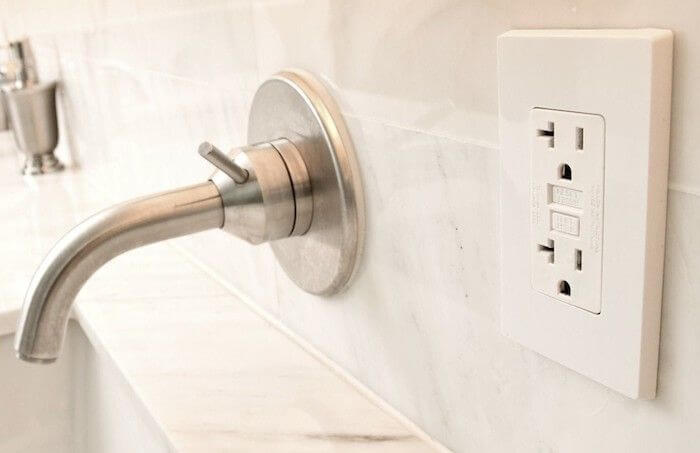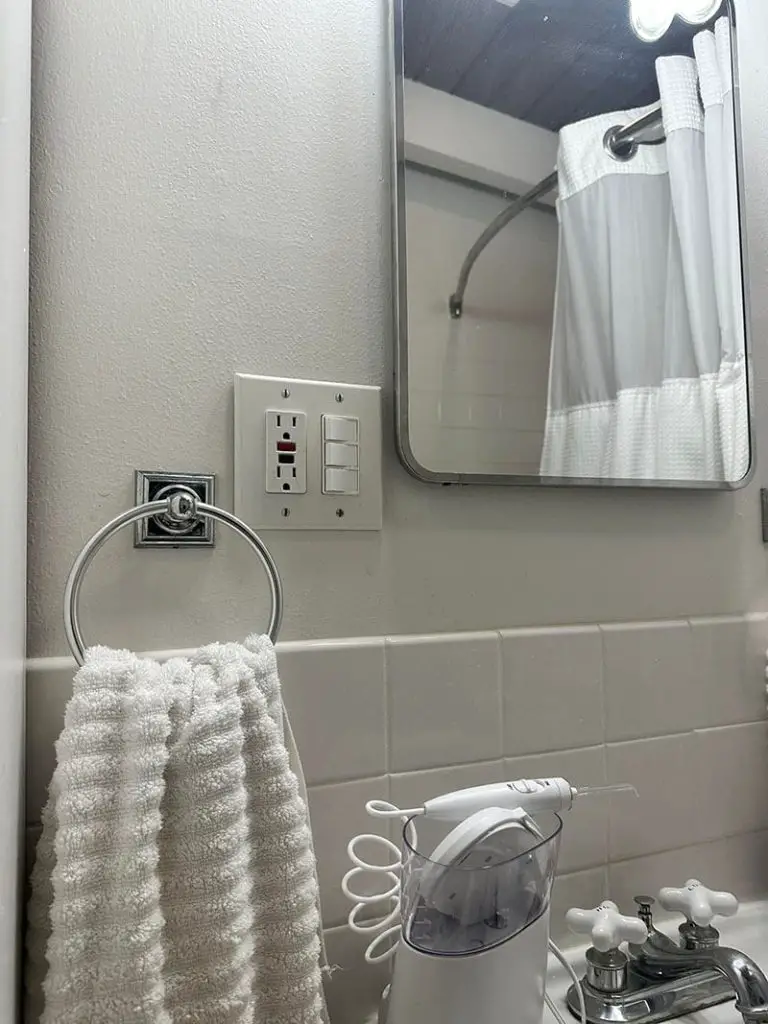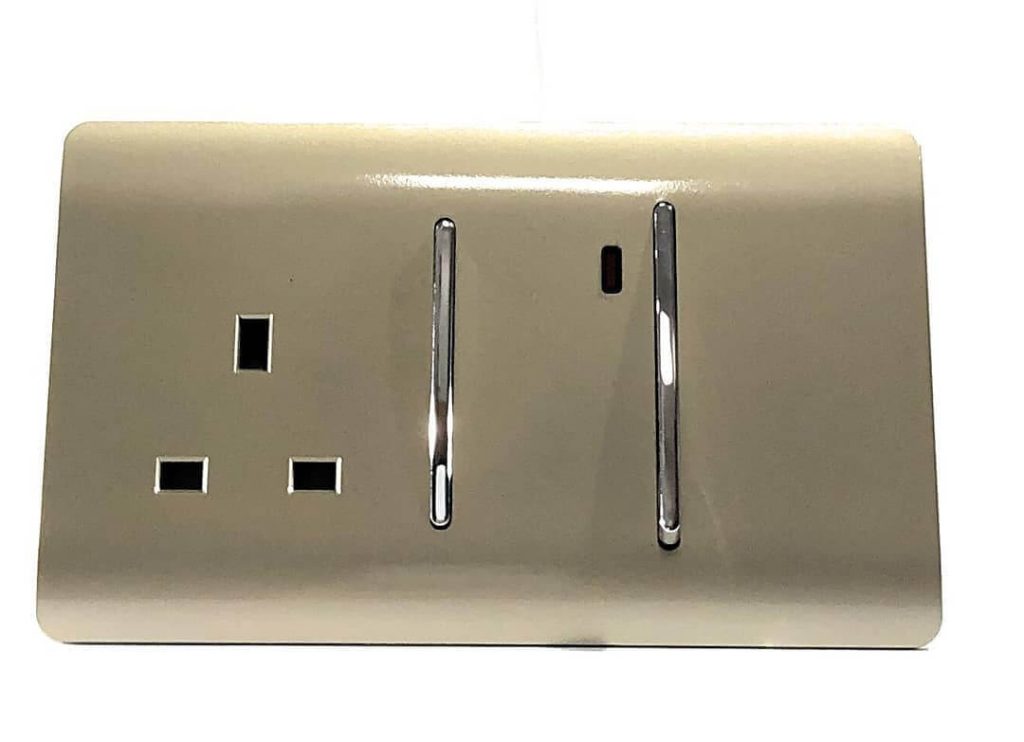At least one GFCI outlet is required in bathrooms, and one or many more might be needed depending on your bathroom appliances. Many years ago, my wife had an electric shock in the bathroom because we didn’t have the proper GFCI outlets.
After that, anywhere I go, whether a new house or a rented one, I ensure that there are GFCI outlets so that no one has to face any kind of accident. Electric accidents are no joke in a bathroom; those can be deadly, so you need to be extra careful.
I will discuss all the risks you might face and give you a reasonable number of GFCI outlets needed for your bathroom.
Quick Jump
5 Electrical Risks Associated with Bathrooms

Regarding bathroom safety, knowing the electrical risks lurking in those damp environments is crucial. Understanding these risks can help you make informed decisions to keep yourself and your loved ones safe. So, let’s dive into it!
Issue #1: Water and Electricity don’t go together (The obvious problem)
Bathrooms are notorious for their water-related activities, making them a prime spot for potential electrical hazards. Water is an excellent conductor of electricity, which means that if your electrical system and water come into contact, you’re looking at a potentially dangerous situation.
Issue #2: Electric Shock
Another primary concern in bathrooms is the risk of electric shock. When water comes into contact with an electrical source, such as a faulty appliance or exposed wiring, it creates a path for the electrical current to flow through your body, leading to an electric shock. And trust me, that’s not an experience you want to have!
Issue #3: Damp Environment
You might have faced that bathrooms are often humid and damp, creating an environment that can accelerate the corrosion of electrical components. Moisture can seep into wiring, outlets, and switches, causing damage and compromising their safety. Corrosion weakens the electrical system, increasing the chances of electrical faults and potential hazards.
Issue #4: Accidents related to Appliances
Nowadays, bathrooms are filled with various electrical appliances like hairdryers, electric razors, and curling irons. Accidental splashes or drops near these appliances can cause water to come into contact with their electrical components, leading to short circuits, electrical shocks, or even fires. The same issue goes if you don’t have GFCI outlets in your kitchen.
Issue #5: Someone made a mistake
Many people like to do their tasks on their own, including me. But knowing your limits regarding electrical DIY work or projects is crucial. Amateur electrical installations or bathroom repairs can result in improper wiring, faulty connections, or inadequate grounding, putting you at risk of electrical mishaps.
It doesn’t matter whether your previous owner made a mistake or anyone else and someone might get hurt. So, you need to be careful.
Do I Need GFCI on Every Bathroom Outlet?

Yes, you do need GFCI on every bathroom outlet. Not just because you, your family, and the bathroom appliances need to be safe, but there are multiple reasons too.
Let me break down the reasons why! First, I already briefly discussed the safety part in the previous section.
Besides, there might be accidents, and GFCI outlets are specifically designed to protect against these risks by quickly shutting off the power if they detect any imbalance in the electrical current. They act as your safety net, preventing electrical shocks and keeping you and your loved ones safe.
Secondly, depending on your area code and other requirements, electrical codes and regulations mandate using GFCI bathroom outlets. These regulations are implemented to ensure the highest level of safety for homeowners. So, by installing GFCI outlets in every bathroom outlet, you comply with the law and demonstrate your commitment to electrical safety.
Thirdly, Having a GFCI outlet on every bathroom outlet ensures comprehensive protection. If you have multiple outlets in the bathroom, a single GFCI outlet can protect all downstream outlets connected to it. So, in the event of a ground fault, the GFCI outlet will trip, cutting off power to all connected outlets and preventing potential hazards.
Fourthly, GFCI outlets also come with handy “test” and “reset” buttons, allowing you to periodically test the functionality of the GFCI outlet and easily reset it if it trips. Regular testing ensures the outlet works correctly, providing peace of mind and continued protection.
Last but not least, Installing GFCI outlets in every bathroom outlet is a smart move that future-proofs your home. Plus, it adds value to your property by highlighting your commitment to electrical safety when it’s time to sell.
That’s more or less why you need to install GFCI on every bathroom outlet. Now that’s sorted, I can continue in the following section.
Common Standards Related to GFCI Outlets in Bathrooms
Whether it’s your first home or a rented one, you might already know the standards for installing GFCI outlets in the bathroom. These standards ensure electrical safety in these wet and potentially hazardous environments.
I won’t bother you with tons of details. But, here is a table.
| Standard | Detail |
| National Electrical Code (NEC) | # Typically required for all 125-volt, single-phase, 15 and 20-ampere receptacles. # Outlets near sinks, showers, bathtubs, or other water sources must be equipped. |
| Location | # Installed within six feet of sinks or water sources. # Easy access to a GFCI outlet. |
| Multiple Outlets | # All of them are GFCI protected. # Installing individual GFCI outlets or a GFCI circuit breaker at each location. |
| Retrofitting | Keep your bathroom’s electrical system in line with current regulations. |
| Exceptions | # Some jurisdictions may have additional requirements or local amendments. # Ensure compliance with any specific requirements in your area. |
How Many GFCI Do You Need In a Bathroom?
It’s essential to make sure you have the right amount to ensure proper electrical safety. The rule of thumb, in this case, is the electrical codes and regulations require at least one GFCI outlet in each bathroom, which applies to residential and commercial settings.
But here are some interesting insights!
- A single GFCI outlet can sometimes protect multiple standard outlets in the same bathroom.
- The reason behind the previous statement is that these standard outlets are connected in a series, known as downstream outlets, and receive GFCI protection from the primary GFCI outlet.
- But another thing is the maximum number of downstream outlets that a single GFCI outlet can protect can vary based on local electrical codes.
- Also, If you have any electrical appliances like hairdryers or shavers in your bathroom, they should be plugged into GFCI-protected outlets. So you might need additional ones.
So, the bottom line is, you will need at least one GFCI outlet in your bathroom, and you might also need a few additional ones depending on the number of appliances you use in your bathroom.
Here is a list of all the bathroom appliances and the amount of GFCI outlets you need for each.
| Electrical Appliance | Number of GFCI Outlets Required |
| Wall-mounted Hair Dryer | 1 |
| Vanity Lights | 1 (Depends) |
| Electric Shaver | 1 |
| Electric Toothbrush Charger | 1 |
| Electric Razor | 1 (Not Always Necessary) |
| Curling Iron or Hair Straightener | 1 |
| Bathroom Scale | 1 |
| Heated Towel Rack | 1 (Not Always Necessary) |
| Whirlpool Bathtub | 1 |
| Jacuzzi Tub | 1 |
| Sauna or Steam Room | 1 |
| Bathroom TV | 1 |
| Bathroom Stereo System | 1 |
Installation and Placement of GFCI Outlets in Bathrooms (DIY)

As you know now how many GFCI outlets are needed in your bathroom, it’s time for proper installation and placement. Let’s dive into the detailed step-by-step guide.
Before getting into that, turn off the power to the bathroom circuit at the main electrical panel. You must locate the appropriate circuit breaker and switch it off.
Now, here are the steps;
- Start by removing the existing outlet cover plate and unscrewing the outlet from the electrical box.
- Carefully disconnect the wires from the old outlet and take note of the wire connections and their respective locations.
- Next, connect the wires to the new GFCI outlet. Remember to connect the black wire to the “Line” or “Hot” terminal, the white wire to the “Neutral” terminal, and the ground wire to the “Ground” terminal.
- Ensure the connections are secure by tightening and folding the wires into the electrical box and positioning the GFCI outlet.
- Turn the power back on at the main electrical panel and press the “Reset” button on the GFCI outlet to enable power.
If you need to install multiple outlets, repeat the installation process. You must ensure the outlets are easily accessible but positioned away from direct water contact. In my experience, a reasonable height above the floor, typically around 12-18 inches, is good enough.
Wrap Up
It might seem like an easy task, but it’s not. Ensuring your family’s safety is crucial, and one way to do that is to install GFCI outlets in your bathroom. I believe I have shared everything I know about this topic, and you won’t have to face any issues determining the outlet count.
Even if you face any, I’m just a mail or comment way, so let me know. Have a good day!

Chino is an accomplished Founder and Home Improvement Contractor with a passion for transforming living spaces into beautiful, functional, and comfortable homes. With years of experience in the industry, he has established himself as a reputable expert in the field, earning the trust and admiration of numerous clients.
